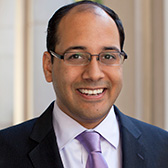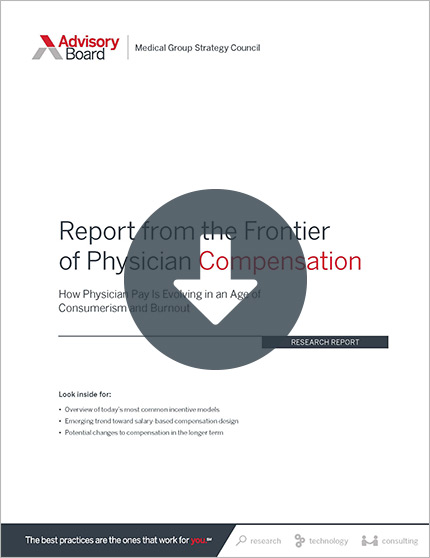Auto logout in seconds.
Continue LogoutRead Advisory Board's take: How to engage physicians in conversations about pay
About half of physicians across various specialties believe they are fairly compensated, according to Medscape's latest Physician Compensation report.
Report details
For the report, Medscape surveyed 19,328 physicians across more than 30 specialties from Oct. 25, 2018, to Feb. 14, 2019. Their responses were weighted based on the American Medical Association's physician distribution by gender, specialty, and state.
Physicians in the survey provided the total amount of compensation they received for providing care. For example, employed clinicians reported their salary, bonus, and income from profit-sharing arrangements, while physician partners and those with solo practices reported their earnings before factoring in income taxes but after factoring in business taxes and deductibles.
One of the questions Medscape asked addressed whether physicians felt they were fairly compensated for their work.
How physicians feel about their compensation
Medscape found physicians in public health and preventive medicine—the specialty with the lowest average annual salary—were the most likely to say they felt they were fairly compensated, while infectious disease physicians and physicians who specialize in diabetes and endocrinology—who also neared the bottom of the average annual salary range—were the least likely to say they felt fairly compensated.
The highest-paid doctors (and the lowest), according to Medscape
Moreover, the report showed that about half of orthopedists—the highest paid specialty—said they felt they were fairly compensated.
See how much different specialties are compensated and what share of physicians in each specialty thinks their specialty is fairly compensated:
(Kane, Medscape, 4/10).
Advisory Board's take


Sarah Evans, Practice Manager, Physician Executive Council and Hamza Hasan, Practice Manager, Medical Group Strategy Council
As this chart shows us, high compensation is not the end-all be-all for either physicians feeling fairly compensated or being more engaged.
Of course, making sure that physician compensation is market competitive is important. But it's equally important to remember that engagement data suggests that once pay hits a certain threshold for each specialty, higher pay doesn't necessarily equate to higher engagement.
“Compensation plans should serve as a bridge between physician performance and health system goals.”
What is important, our research shows, is that physicians understand health system and medical group strategy—and that they can see how their compensation plan supports that strategy. Compensation plans should serve as a bridge between individual physician performance and health system goals.
The first step of conveying your health system strategy to physicians is to make sure it's clear to your own leadership. To clarify it for your team, ask questions that inform your approach for the basic structure of compensation (like the balance between productivity and pay-for-performance, strategic goals for performance incentives, and the level of financial investment you want to make in your market.) For instance, ask:
- Is your market moving toward value-based purchasing, or will you continue to live in a fee-for-service world?
- Are you eligible for reimbursement bonuses, or do you face penalties for clinical outcomes or readmission rates?
- Is increasing patient access to match demand a challenge, or are your physicians under-utilized?
- What level of strategic investment is your group willing to make in certain clinical specialties?
Then, once your strategic priorities are clear, you should involve physicians from the beginning in any efforts of compensation redesign. Clinicians and service line leaders usually better understand that physicians can accomplish, what quality metrics deserve the most attention, and how performance incentives will translate into action. Empowering them to contribute on selecting metrics, determining threshold levels, and setting other details will likely yield the best results.
“Shared decision making creates a sense of ownership from the start”
Further, shared decision making creates a sense of ownership from the start, and likely will lead to less resistance down the line—turning potential detractors into the plan's champions.
Not to mention, communicating strategic priorities and involving physicians in crafting these priorities isn't just important in questions about compensation, it's an essential component of all physician engagement efforts. For instance, we recently conducted a national-level analysis of employed and independent physicians aimed at uncovering the top-opportunity drivers of engagement, looking for drivers that had a statistically significant impact on engagement, did not require outsized investment, and on which organizations nationally had significant room to improve.
We identified six drivers, or statements that, if physicians agreed with, meant they were far more likely to be engaged. The statements included:
- The actions of this organization's executive team reflect the goals and priorities of participating clinicians;
- This organization is well prepared to meet the challenges of the next decade;
- I view this organization as a strategic partner in navigating the changing healthcare landscape;
- This organization is open and responsive to my input;
- This organization recognizes clinicians for excellent work; and
- I am interested in physician leadership opportunities at this organization.
The good news: Adopting initiatives to help your physicians agree with these statements doesn't require outsized investment. Rather, leaders can move the dial on engagement by improving day-to-day communications and meeting structure—and by involving physicians early on in new change initiatives. And our analysis suggests that higher engagement levels act as a buffer against physician burnout.
To get a nine-step plan for including physicians in conversations about compensation, view our report on Engaging Physicians in Compensation Redesign. Then, to get the tools you need to improve communications with physicians, view our Physician Communication Toolkit.
Don't miss out on the latest Advisory Board insights
Create your free account to access 1 resource, including the latest research and webinars.
Want access without creating an account?
You have 1 free members-only resource remaining this month.
1 free members-only resources remaining
1 free members-only resources remaining
You've reached your limit of free insights
Become a member to access all of Advisory Board's resources, events, and experts
Never miss out on the latest innovative health care content tailored to you.
Benefits include:
You've reached your limit of free insights
Become a member to access all of Advisory Board's resources, events, and experts
Never miss out on the latest innovative health care content tailored to you.
Benefits include:
This content is available through your Curated Research partnership with Advisory Board. Click on ‘view this resource’ to read the full piece
Email ask@advisory.com to learn more
Click on ‘Become a Member’ to learn about the benefits of a Full-Access partnership with Advisory Board
Never miss out on the latest innovative health care content tailored to you.
Benefits Include:
This is for members only. Learn more.
Click on ‘Become a Member’ to learn about the benefits of a Full-Access partnership with Advisory Board
Never miss out on the latest innovative health care content tailored to you.

